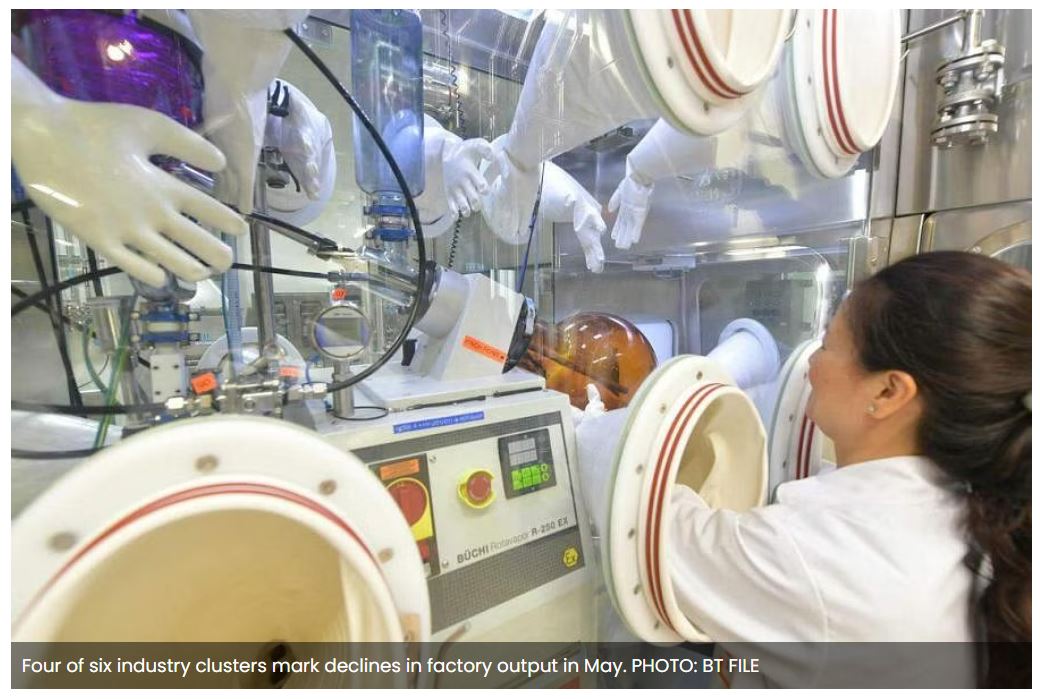Singapore’s factory output falls by steeper-than-expected 10.8% in May
SINGAPORE’S manufacturing output slid 10.8 per cent on year in May, worse than April’s surprise 6.5 per cent fall and the median 7.3 per cent contraction forecast by private-sector economists in a Bloomberg poll.
The month’s figures marked the eighth straight month of decline, data from the Singapore Economic Development Board indicated on Monday (Jun 26). It is also the first double-digit drop recorded since November 2019, when factory output fell 12.3 per cent year on year.
Excluding the typically volatile biomedical cluster, factory output shrank 13 per cent, following the 5.7 per cent year-on-year fall in April.
The latest figures came as the majority of clusters recorded declines, including the key electronics cluster. They are the latest in a weakening manufacturing outlook, with Singapore’s purchasing managers’ index posting a third consecutive month of contraction in May on a protracted electronics downturn. Non-oil domestic exports also posted a steeper-than-expected slide last month.
In May, the linchpin electronics cluster posted another weak showing. Output was down 23 per cent year on year, deepening from the 8.7 per cent contraction in the month before.
The infocomms and consumer electronics segment was the only one to record growth, up 22.7 per cent. The other electronic modules and components (-9.2 per cent), computer peripherals and data storage (-26.6 per cent), and semiconductors (-26.8 per cent) segments contracted on the back of declining demand.
Also reporting a double-digit fall in output was precision engineering, which shrank 10.5 per cent on year, against April’s 3.8 per cent drop.
Its precision modules and components segment slid 10 per cent due to lower production of plastic and metal precision components, electronic connectors and dies, moulds, tools, jigs and fixtures. The machinery and systems segment declined 10.1 per cent, driven by lower output of semiconductor equipment and refrigeration and air-conditioning compressors.
Other clusters that posted declines were:
- Chemicals (-9.5 per cent)
- General manufacturing (-0.3 per cent)
The remaining clusters grew.
Transport engineering output was up 28.4 per cent in May, compared with 14.9 per cent in April.
The aerospace segment grew 35.9 per cent on account of higher demand for aircraft parts from the US and Europe, as well as more maintenance, repair and overhaul jobs from commercial airlines on the back of increased global air traffic. The marine and offshore engineering segment expanded 31.5 per cent, supported by a higher level of activities in the shipyards as well as increased production of oil and gas field equipment.
Output in the land segment, however, continued to contract, albeit at a slower rate. It was down 3.5 per cent in May, easing from a 9.4 per cent decline in April and a 19.1 per cent drop in March.
Volatile biomedical manufacturing reversed from April’s 11.1 per cent drop to post 4.4 per cent year-on-year growth in May.
Output of the pharmaceuticals segment increased 6.3 per cent, mainly from a different mix of active pharmaceutical ingredients being produced compared to a year ago. The medical technology segment grew 0.4 per cent, supported by export demand for medical devices.
On a seasonally adjusted, monthly basis, manufacturing output decreased by 3.9 per cent in May, deepening from the preceding month’s 1.6 per cent decline.
Excluding biomedical manufacturing, factory output fell by 8 per cent, reversing from April’s 2.5 per cent gain.
For the year to date, overall manufacturing slid 6.7 per cent year on year, or 7.4 per cent excluding biomedical manufacturing.
Source: https://www.businesstimes.com.sg/singapore/singapores-factory-output-falls-steeper-expected-108-may


 English
English




